There are many challenges when organising a paddling trip – even before the actual trip starts.
For example: What about logistics?
Page Contents (click line to jump the text)
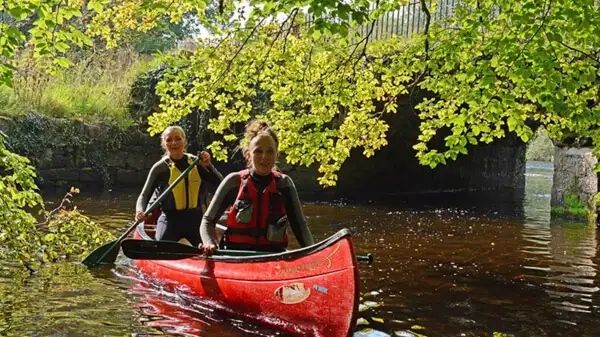
Intro
Of course you can park your boat at the headwaters of the Shannon, paddle 100km down the river and have a taxi take you back to your car, or find a bus to take you back.
If you’re travelling with friends, you can park one car at the start and one at the finish – sure. But if you’re paddling alone and your wife or family has other interests and wants to see a bit more of Ireland than just a river or lake?
Exactly! Now you’re in trouble!
But I won’t leave you hanging, because we’ll find a solution for this scenario too: Just make a round trip by car along many sights and pretty little towns.
And in between, launch your boat and paddle a half-day or day trip while your companion does something else nice.
Cool? Then let’s get started!
Which kayak for universal day trips in Ireland?
This trip is not just about paddling, but also. That means the boat should fit in – in the car, and also fit into the holiday “unobtrusively” in other ways.
The 5-metre sea kayak on the roof is impractical for the journey and unwieldy on the road. You don’t need that much boat and storage space, because you’re not going on a long camping trip.
Of course, you can transport a medium-sized hard-shell kayak on the roof of a car, but there is the question of theft, especially in cities, and on the motorway it is not necessarily a pleasure.
A folding boat takes longer to set up and take down, and the metal parts of the inner rods don’t like salt water – no, not even the aluminium rods.
When you paddle rivers and canals, you’ll want to go around a lock or weir every now and then – well, if the boat is very light, you won’t need a boat trolli.
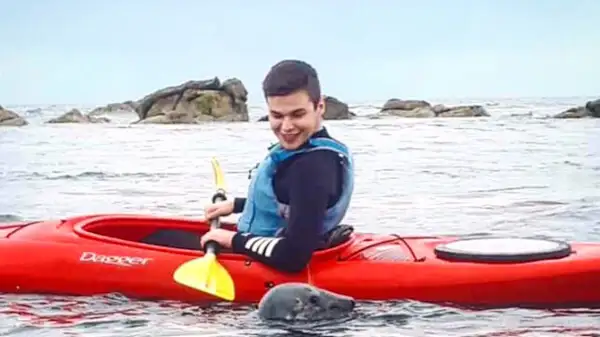
The kayak should be quick and easy to set up and take down, so that even a short paddle “in between” makes sense.
A medium-sized air or hybrid boat in the boot doesn’t take up too much space, is super quick to set up, has enough room for a waterproof luggage roll as day luggage and is at home on almost any body of water.
You might not want to use it on the coast in wind, current or bad weather, but that might be a good idea anyway if you don’t know the local conditions.
Examples of good inflatable boats suitable for travelling: Gumotex Swing1 or Advanced Elements Advanced Frame / Ultralite or Nortik Scubi 1/XL
Travel to Ireland and return
You can also take your kayak as sports luggage by plane and then load it into a rental car, but you will probably travel by your own car.
In principle, there are 4 options for travelling by car:
- by ferry or Eurotunnel from Calais (France) to southern England (Dover) and then by ferry from South Wales (Fishguard or Pembroke) to Rosslare or from North Wales (Holyhead) to Dublin (Ireland).
- take the overnight ferry from Rotterdam or Bruges to Hull and then the ferry from North Wales (Holyhead) to Dublin.
- overnight ferry from Rotterdam or Bruges to Hull and then via Southern Scotland (Cairnryan) to Northern Ireland (Larne or Belfast).
- by overnight ferry from Cherbourg (France to Rosslare or Dublin).
I have tried all these options myself several times, because we have had our second home in Ireland for several years now.
I can’t recommend option 1. You can get to Calais easily, but the traffic in the south of England is no fun, especially around London and also near Birmingham. Even in Wales it is very busy because an incredible amount of trucks use these routes. Option 2. is similarly annoying, because here you also have to pass busy cities.
If you come from Southern Germany or the Alps, I can recommend option 4. But don’t go via Paris, but via St.Quentin, Amiens and LeHavre. The motorways in northern France are very easy to drive.
If you come from northern Germany, you can take option 3 via Hull and southern Scotland. Beautiful route, easy to drive, little traffic.
Best time to travel and travel duration
What is the best time to travel? Statistically, early summer has slightly less rainfall than late summer. So much for the theory. In practice, the weather in Ireland can always be changeable. Sun, clouds, showers, wind, rain, sun – etc…. If you don’t like our weather, wait 20 minutes! Nothing to worry about if you have a rain jacket – and sunglasses and a cap.
Temperatures are warmest from mid-June to late July, when you can expect 20-25 degrees, rarely more. In May and August it tends to be around 20 degrees. Early September is often a great time to travel, with mild temperatures around 15-18 degrees and often nice weather. In autumn, winter and spring it can be cool, wet and especially stormy.
The Irish school holidays run from late June to early August. It is certainly most crowded at the seaside resorts in July. My tip is to travel in June or August.
How long should the trip last? You should have at least two weeks in Ireland. For arrival and departure you can add another 4-5 days, depending on where you start from.
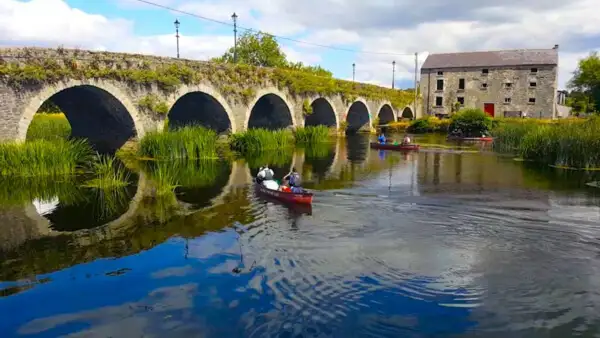
The slightly different itinerary around the Irish island
Let’s say you want to go around the island, visit many beautiful Irish must-see locations but also paddle. How could such a trip look like?
Day 1: Let’s start in Dublin: The city is definitely worth a visit. The old town lies around the Temple Bar district and directly on the River Liffey, which stretches all the way to the harbour. In Dublin you can also paddle on the River Liffey, the Grand Canal and the Royal Canal.
Day 2: The beautiful beaches of the south-east coast: You drive south along the coast. The most beautiful beaches are at Morriscastle (Kilmuckridge) and at Curracloe. If the weather is calm, you can also paddle there, but beware of tides, wind and current!
Overnight at Enniscorthy.
Day 3: Launch your boat at Enniscorthy and follow the River Slaney to Wexford. If that’s too long, you get in the water later. Meanwhile, your companion has plenty of time to visit Enniscorthy and Wexford, where you meet up again.
Day 4: In New Ross harbour is the Dunbrody, a replica of a sailing ship once used by Irish emigrants to sail to America. It’s well worth a visit, and there’s also a small museum and a café. Waterford was originally founded by Vikings, as was Wexford. There are several museums, a little old town and a nice harbour. For the paddler, there’s the River Barrow and the River Suir – drop your kayak somewhere and just make a destination. Continue to Kinsale.
Day 5: Kinsale is officially the southern starting point of the Wild Atlantic Way. A nice harbour town with a beautiful sheltered bay (!), an old fort over the bay and a nice marina – beautiful on land and water. On the way to Baltimore you will pass several beautiful sheltered bays, e.g. Klonakilty, Rosscarbery, Glandore and Rinneen. Baltimore is a lovely old fishing harbour in a rugged bay with islands. Again, a dream on foot and a dream on water!
Day 6: Drive around the island of Beara and if the weather is nice, drive over the beautiful Healy Pass in the interior of the island. Beara is a dream! Paddle in Bantry Bay or Kenmare Bay if the weather is good. Continue through Killarney National Park to Killarney.
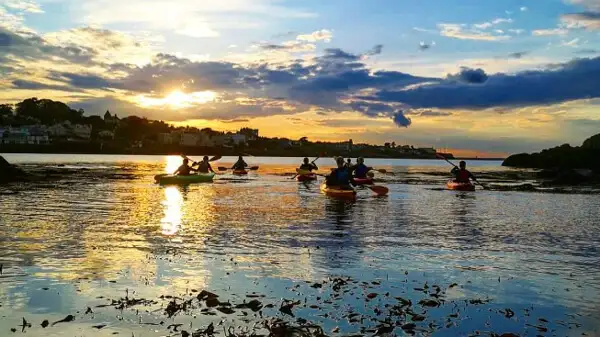
Day 7: Killarney is a lively place with lots to do: Hiking, mountain biking, excursion boating on the lake, carriage driving, chilling out, wellness, there is an old castel and Muckross House is very beautiful. Many things are possible here. For example, you can take a carriage ride together to Upper Lake Killarney, get off there and paddle back to Muckross Lake.
Day 8: Tour around the beautiful island of Dingle, overnight at Limerick or Bunratty. Limerick is an interesting town and Bunratty has a very nice castle! You can drop off your kayak on the River Shannon above Limerick and you will meet back in Limerick later.
Day 9: You will drive to the Cliffs of Moher and along the beautiful coastal road along the Burren. The Burren is a barren, rocky group of hills with stalactite caves inside. Be sure to take the R477 around the headland, it is truly magnificent. Galway is lively and you can shop, eat, listen to music and enjoy the beautiful seafront. You can also stay outside and just drive in for a meal. North of Galway is Lough Corrib, which is great for paddling, or the River Corrib, which runs all the way to Galway – where you can meet up again.
Day 10: The mountainous hinterland of Connemara is super fast and a must on your trip. Head towards Clifden and drive either via Clifden or the R344 past Lough Inagh (paddle break?) to Kylemore Abbey. This is a beautiful little castle with beautifully landscaped gardens in a lovely hillside location – and there is also a lake on the other side of the road (Kylemore Lough). We continue to Clog on Killary Fjord. There is food there and a small waterfall (Aasleagh Falls) and a long sea inlet – which is actually the only real fjord in Ireland! Overnight in Westport.
Day 11: Westport is a nice little town with several places to stay and eat. From here you head towards Achill Island. Near Newport you will pass Burrishoole Abbey – a beautiful abbey, or rather ruins, right on the water. Behind the Celtic crosses are fishing boats (paddle break?). Newport Bay has hundreds of small islets. In the past, this was a retreat for Irish pirates who attacked English ships and then disappeared into the labyrinth. It’s also nice to paddle in good weather.
You can reach Achill Island via a small bridge. The island is simply beautiful. Drive along the rocky south coast to Keel and then take the small pass road to Keem Bay. You can drive back through the interior of the island. Overnight again in Westport.
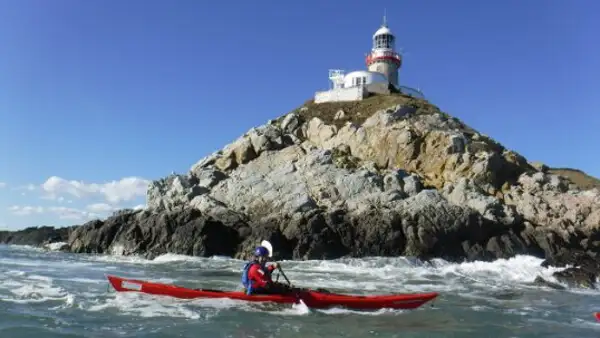
Day 12: Sligo is an interesting town with several places of interest, such as Sligo Abbey. North of it there is a nice waterfall (Glencar Waterfall) at the foot of the table mountain massif of Benbulben and directly in front of it (such a coincidence) a lake (Glencar Lough). East of Sligo there is a lake, Lough Gill. On its shore is the pretty Parke`s Castle near Kilmore. The Garvoge River connects the lake to the sea and flows through Sligo.
Day 13: Drop off at Drumshanbo or Leitrim Village and follow the upper reaches of the River Shannon to Carrick on Shannon. You can meet there for a lunch break and then continue a little further and be collected again later. This or similar will make for a great day’s paddling. For your company, Carrick-on-Shannon is a pretty nice place with lots of colour and life. A lot of recreational captains stop there with their houseboats, so everything you need and want is provided for.
Day 14: Today we head back to Dublin. You can stop in Mullingar. This nice little town offers plenty of opportunities for a nice lunch break. On Lough Ennell south of the town is Belvedere House Gardens and Park. A former stately home with a beautiful park – right on the lake. Before you reach Dublin, you can be dropped off at the Royal Canal and kayak the last few kilometres into the city – where you’ll meet up again!
Finally
So, that was 14 days of paddling and non-paddling in Ireland! The combination tour for two or for the family.
This is far from being an organized paddling trip, but it is just meant to be an inspiration.
You can have a great Ireland vacation together, even if only one of you wants to paddle!
Happy planning and have a great Ireland vacation!
More interesting articles for you
WHERE CAN I GO KAYAKING ON THE COAST IN IRELAND?
WHICH KAYAK IS BETTER FOR THE IRLAND TRIP: AIRBOAT, FOLDING BOAT OR HARD-SHELL KAYAK?
YOUR COMPLETE PACKING LIST FOR A MULTI-DAY PADDLING TOUR ON IRELAND’S INLAND WATERS
Photo credits cover photo: Ulrich Knüppel-Gertberg (www.irland-insider.de, www.ireland-insider.com)